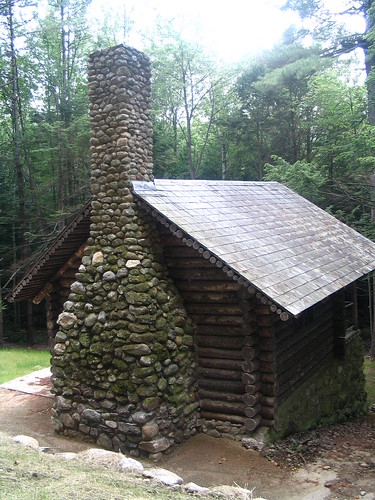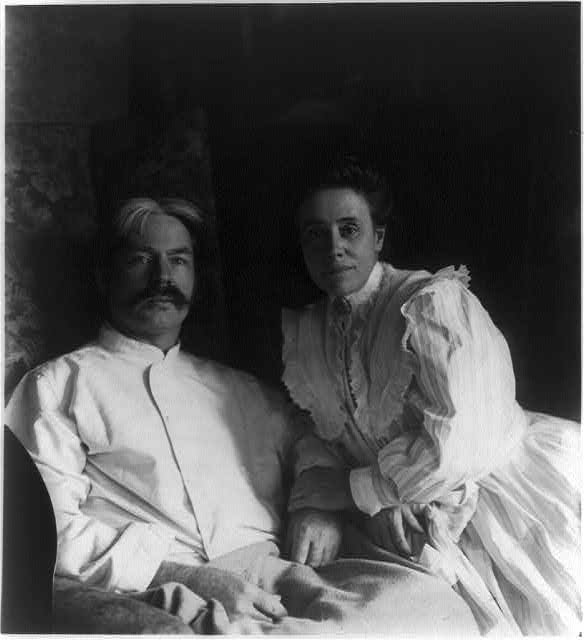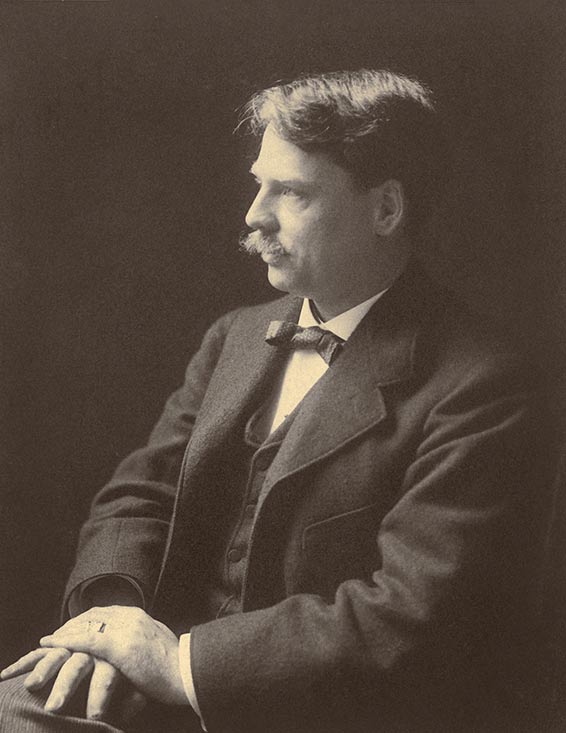Otras Obras: Concierto para piano No. 1 en La menor, Op. 15, Hamlet y Ofelia, Op. 22, Concierto para piano No. 2 en Re menor, Op. 23, Suite No. 2, Op. 48 'India'.
Biografía: Compositor norteamericano nacido en Nueva York, el músico estadounidense más representativo del siglo XIX. De familia acomodada, recibió sus primeras clases de piano en Nueva York, para más tarde perfeccionarlas en el Conservatorio de París y en Alemania. Con 21 años se convirtió en instructor de piano en el Conservatorio de Darmstadt, interpretando para Franz Liszt su primer Concierto para Piano, en Weimar. En 1886 compuso su 2º Concierto, que supuso su retorno triunfal a los Estados Unidos dos años después. Su reputación creció rápidamente y antes de que pasara mucho tiempo era el compositor más famoso de su país. A partir de entonces vivió en Boston y más tarde en Nueva York, dónde fue profesor en la Universidad de Columbia. Fue uno de los fundadores de la Academia Norteamericana de Artes y Letras, transformando su casa de verano en Peterborough, New Hampshire, en una colonia para artistas. ©
epdlp
Edward Alexander MacDowell (1860-1908) [biography]
Edward MacDowell was one of the most celebrated American composers in the nineteenth century. His compositions won the approval of music critics, both in Europe and the United States, as well as of his contemporaries, including composers such as Franz Liszt and Joachim Raff. MacDowell's early works bear the influence of his training in Germany, reflecting European styles and cultures. Nearly all of his compositions feature descriptive titles, a trend representative of Romantic music. He was among the first seven Americans honored by membership in the American Academy of Arts and Letters (1904).
While there has been controversy in determining his birth year, recent evidence suggests that MacDowell was born in New York City on 18 December 1860. The son of Thomas MacDowell and Frances "Fanny" Knapp MacDowell, the youth grew up in a Quaker household on the Lower East Side of Manhattan. Frances MacDowell firmly believed that Edward should have music lessons, so she arranged for her eight-year old son to take piano lessons from Colombian violinist Juan Buitrago. MacDowell soon surpassed Buitrago's abilities and began studying piano with Cuban pianist Pablo Desverine. Desverine's lessons were supplemented by sessions with Venezuelan pianist Teresa Carreño, who later championed MacDowell's works.
In 1876, at the age of fifteen, MacDowell, accompanied by his mother, traveled to France to enroll in the Paris Conservatoire. He earned one of the conservatoire's scholarships awarded to foreign students and gained admission to Antoine François Marmontel's studio. Marmontel was one of the most sought-after piano teachers of the time, and he accepted only thirteen students, including MacDowell, out of 230 applicants. After only two years, MacDowell grew dissatisfied with the instruction at the conservatoire and moved to Germany to continue his education.
In the fall of 1879, MacDowell entered the Frankfurt Conservatory, where he studied piano with Carl Heymann and composition with Joachim Raff. It was during this time that MacDowell became acquainted with Franz Liszt. Upon visiting Raff's class in early 1880, Liszt heard MacDowell play the piano part of Robert Schumann's Quintet, op. 44 (Schumann's widow, Clara, was also present at that performance). The following year, MacDowell visited Liszt in Weimar and played his own Piano Concerto in A Minor, op. 15, for the maestro. On Liszt's recommendation, MacDowell's First Modern Suite, op. 10, was performed on 11 July 1882 at the Allgemeine deutsche Musikverein; Liszt also encouraged the prestigious Leipzig firm of Breitkopf & Härtel to publish the work.
After Heymann's retirement in 1881, MacDowell began his professional career as a teacher at the Darmstadt Conservatory. He resigned a year later, but continued to teach privately. He fell in love with one of his students, Marian Nevins, whom he secretly married on 11 July 1884 (a public ceremony followed on 21 July). The couple lived in Germany for several years, during which time MacDowell dedicated himself solely to composition. He achieved fame with his Piano Concerto in A Minor, op. 15, which was championed by Carreño, and his Fantasy Pieces, op. 17.
Financial difficulties forced the MacDowells to return to America in 1888, and for nearly ten years they resided in Boston. Among the compositions penned by MacDowell during this period was his Indian Suite, op. 48 (1896), for orchestra, one of his most famous works. In 1896 the MacDowells purchased land in New Hampshire, and in a cabin built on this property, Edward composed his Woodland Sketches, op. 51 (1896), for piano. The natural surroundings of this New Hampshire retreat would ultimately inspire generations of composers, for it was in this location in 1907 that the MacDowell Colony was established. The colony, a sanctuary for composers, painters, authors, and sculptors, continues to sponsor and support artists to this day.
MacDowell joined the faculty of Columbia University in 1896. As the sole music professor at the university for nearly two years, MacDowell also served as the department's administrator. In addition to teaching, he directed the Mendelssohn Glee Club (New York). He also started an all-male chorus at Columbia University in order to raise artistic standards of college glee clubs and music societies.
MacDowell's compositions include two piano concertos, two orchestral suites, four symphonic poems, four piano sonatas, piano suites, forty-two songs, and choral music, most of which is for male voices. He also published dozens of piano transcriptions of eighteenth-century pre-piano keyboard pieces.
MacDowell wrote a great deal of solo song repertoire between 1880 and 1901. Early songs were on German texts by Heine, Klopstock, and Goethe; later he set texts by Shakespeare, Burns, Gardner, and Howells, as well as his own poetry. For the Mendelssohn Glee Club, he wrote nine arrangements for male voices of works by Borodin, Sokolov, Rimsky-Korsakov, and others, which the Club premiered. He also arranged and composed college songs for Columbia University's men's glee club.
From 1896 to 1898, MacDowell published four part songs for the Mendelssohn Glee Club under the pseudonym of Edgar Thorn. Since MacDowell conducted the group, he feared members would feel obligated to accept his compositions if he revealed he had written them. MacDowell also wrote nine other works under his own name. Eight of his works were premiered by the Mendelssohn Glee Club under his direction between 1897 and 1898.
In 1904, after serious disputes with Murray Butler (the new president of Columbia) regarding the role of the university's music program, MacDowell resigned from the post. As a result of the trauma associated with the much-publicized event at Columbia, an accident with a hansom cab, and his depression and general declining health, MacDowell's condition rapidly deteriorated, and he died on 23 January 1908. Marian MacDowell, however, survived her husband by nearly five decades, spending the majority of her remaining years tending to the MacDowell Colony's operations. After Marian's death in 1956, her estate sold MacDowell's materials to the Library of Congress in 1972, allowing researchers and scholars access to the holograph manuscripts, correspondence, and personal papers of one of America's most prominent composers.
(http://lcweb2.loc.gov/diglib/ihas/loc.natlib.ihas.200035715/default.html)
Log cabin used by Edward MacDowell:
 |
Log Cabin
This was the private studio of Edward MacDowell. His wife, Marion, had to built as a gift to him. It is under reconstruction.
|
By Keith Call
Edward MacDowell (1860-1908), pianist and composer, felt that the productivity he enjoyed in his later years was the result of the uninterrupted leisure and pine-scented countryside of Peterborough, New Hampshire, where his summer retreat was located. Comfortable in his cabin situated a few years from his home, Hillcrest, he created the Norse and Celtic sonatas, the New England Idylls, the Fireside Tales, and many other songs and choruses. So far out in the woods, the property offered the deep pervading solitude of a primeval forest. During his final illness MacDowell fretted as to what might happen to this beloved patch of earth, hoping that it might continue providing a safe haven for other artists. As he lay dying, his wife, Marian, promised him that she would devote her life to fulfilling his dream. Shortly before he died, the Mendlessohn Glee Club had raised funds for an as-yet undecided memorial; at the suggestion of Mrs. MacDowell, the memorial took the form of an endowment of the Peterborough property for the purpose of establishing an art colony.
Feeling strongly that the various arts all spring from the same impulse, Edward MacDowell encouraged his students to expose themselves to other forms. For instance, the musician should know something about painting; and the sculptor should know something about poetry. The best way to accomplish this was to congregate representatives of all arts, acquainting them with one another. And so the Colony was instituted, acquiring additional acreage in the following decades – though most of it remained undeveloped to preserve the rich forest. Studios and cabins were built, each sufficiently secluded to afford privacy and productivity. Men had their own houses, the women theirs. Residing at Hillcrest, Mrs. MacDowell supervised the construction of studios, roads and the farm. In addition, she traveled far and wide, delivering lecture-recitals, raising substantial support for the 600-acre Colony.
(http://recollections.liblog.wheaton.edu/2011/10/14/the-macdowell-memorial-colony/)

Marian MacDowell in front of Edward's log cabin, the Colony's prototype studio. Archival image.
Full Caption: Marian and Edward MacDowell. Photograph, ca. 1905. MacDowell Colony Records.
Prints and Photographs Division (unprocessed). LC-USZ62-92627.
This formal portrait of Marian and Edward MacDowell was made around 1905. Edward's final illness is evident in his vacant stare and graying hair, which turned completely white within a year's time. Marian's sure and steady gaze as she leans protectively towards her husband, her hand on his arm, lends a certain poignancy to the photo, one of the last taken of them together.
http://www.examiner.com/community-in-manchester/log-cabin-used-by-edward-macdowell-a-composer-and-founder
http://lcweb2.loc.gov/diglib/ihas/loc.natlib.ihas.200035715/default.html
http://www.macdowellcolony.org/news-PressImagery.html
http://memory.loc.gov/ammem/awhhtml/aw08e/aw08e.html
http://memory.loc.gov/ammem/awhhtml/aw08e/d4.html
http://kimwood.org/ponderings/index.php/page/40/
http://www.epdlp.com/compclasico.php?id=4253







 nº 1 - To A Wild Rose
nº 1 - To A Wild Rose

No hay comentarios:
Publicar un comentario